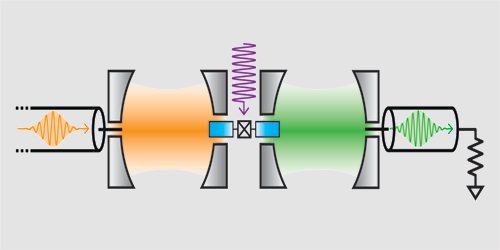Efficient Detection of Microwave Photons
High-performance single-photon detectors work by transforming the energy of an incoming optical-frequency photon into a measurable electrical signal. Detecting single microwave photons is more challenging, however, as microwave photons carry 5 orders of magnitude less energy than optical ones. Now, Raphaël Lescanne, of the French National Center for Scientific Research (CNRS), and his colleagues demonstrate a new microwave-photon detection method that improves on existing techniques by yielding significantly fewer false positive detections.
Recently developed microwave-photon detectors use two-level quantum systems—qubits—to capture information about incoming photons: photons are detected when they cause the qubit to acquire a given phase. However, qubits also undergo phase shifts randomly because of decoherence, so brief qubit coherence times in these devices lead to high rates of false positive measurements. To overcome this problem, Lescanne and his colleagues created a detector that does not rely on qubit coherences.
In their experiment, an incoming microwave photon is captured in a microwave resonator, which is coupled to a superconducting qubit. When a strong microwave tone—the “pump”—is applied to the qubit, the incoming photon and one pump photon interact, putting the qubit in an excited state. This process also creates a third photon in a “waste” resonator, where it immediately dissipates. Because the waste photon is lost, the reverse process (where the qubit emits a photon) cannot occur, and the qubit excitation therefore lasts long enough to be measured by standard readout techniques. As the qubit coherence time does not affect the detection mechanism, the team achieves a false positive rate that is an order of magnitude lower than state-of-the-art microwave photon counters.
This research is published in Physical Review X.
–Rachel Berkowitz
Rachel Berkowitz is a Corresponding Editor for Physics based in Seattle, Washington, and Vancouver, Canada.




